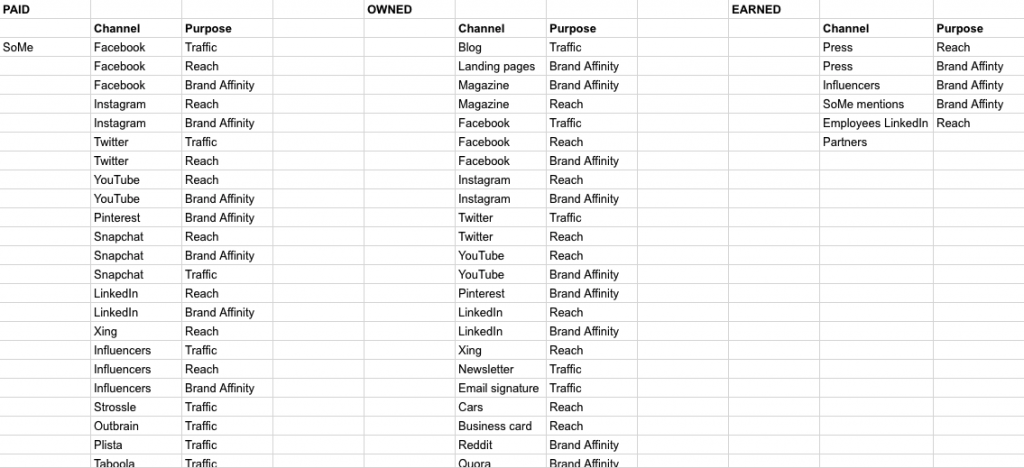 Details
Details
Let me guess, you’re challenged with user engagement on social media, and the reach you get on the content you distribute on Facebook, Instagram and LinkedIn is gradually becoming lower and lower.
No need to fret, you’re not the only one.
Many companies are getting increasingly frustrated when they share content on social media because post reach and user engagement is lower than it’s ever been before. In fact, in 2018, the estimated organic reach of Facebook has been 1.2%.
This is why it’s important that you promote your content, in order to increase reach and user engagement.
I’ll tell you how you can get the maximum effect out of your marketing efforts with paid distribution and how you can get started with distributing content.
The more precisely defined your target audience is, the better the results of your paid advertising.
Step 1: Lay the foundation for your social media efforts
You start with defining the foundation for your social media efforts. It might sound like a difficult task, but you can basically do this by answering 4 questions.
- Who’s your target audience?
- What actions do you want your target audience to complete?
- What are these actions worth to you?
- How much money should you use?
When you work with content distribution, it’s critical that you know who your core audience is, otherwise you’ll never get a significant return on your efforts. It’s therefore essential that you’re clear about who it is you want to reach.
RELATED: The Future of Native Advertising: Much More Use of Data, Analytics and Programmatic
The more precisely defined your target audience is, the better the results of your paid advertising.
When you pay to place an ad in your target group’s feed on Facebook, for example, you should, of course, also define which action you would like your target group to carry out.
Should they visit your website? Should they download an E-book? Or should they sign up for a seminar?
Once that’s in place, you should find out what that particular action is worth to you. This will help you with deciding how much money you should use on your social media campaign.
I recommend you get inspiration from other companies and their ads.
Step 2: Plan your distribution
With the foundation of your social media efforts are in place, you’re ready to make a distribution plan. I recommend you keep these seven questions in mind while you compile your plan.
- Which social platform does your target group use? ( When they’re in the right mindset)
- Can you carry out the content distribution yourself, or do you need an external partner?
- Do your content and brand fit the platform?
- Which ad formats do the platforms offer? ( Video, picture carousel, slideshow, etc.)
- What does it cost, and what is the price structure? ( Is there a possibility of getting external help)
- Can you find proof of concept or inspiration?
- How can you measure performance and ROI?
RELATED: Why You Can't Have Content Without a Content Strategy
Some of these points are for you to decide, others are maybe a bit harder to address. It’s important, though, that you are as thorough as possible. It pays off in the end.
I recommend you get inspiration from other companies and their ads. In addition, it’s always a good idea to find proof of concept on the platform that you’re considering placing a paid ad on.
For example, does Facebook have an example case on lead generating ads that you can relate to?
Facebook is good for both generating traffic, reach and brand affinity.
Step 3: Create an overview of the possible distribution channels.
Start with carrying out a brainstorm, where you take note of all the distribution platforms you can think of. After that, define the purpose of the various platforms. For example, Facebook is good for both generating traffic, reach and brand affinity.
In the image, you can see an example of an overview table:

If you follow my distribution plan, I promise you will be well on your way to success with paid advertising
Step 4: Draw up your distribution plan
For my clients, I always work with a distribution plan so I can have a better overview of our various social media campaigns, both with regard to goals but also with regard to budget, KPIs and tests.


If you follow my distribution plan, I promise you will be well on your way to success with paid advertising.
You can download the plan right here (it’s not even gated).
Step 5: Execute your distribution plan
When you’ve reached the last step, you’re ready to execute your distribution plan.
Remember to continuously monitor your campaign and adjust your efforts as needed.
Set SMART goals for your social media efforts
Goals form the basis for your social media efforts. With them, you can prove the effect of your efforts and can be motivated to go the extra mile.
The problem is, many marketing departments set goals that aren’t measurable, are unspecific, unattainable, irrelevant, or don’t have a specific deadline.
RELATED: How Not to Waste Money on Native Advertising
This is why you should use the SMART model instead when you set goals for your social media efforts. Each letter in the model stands for a quality that your goals need to live up to. Your goals should be:
- Specific
- Measurable
- Attainable
- Relevant
- Timely
It’s hard to measure something that isn’t specific or unique. Therefore, your goals should be formulated such that there’s no doubt about what’s being measured. Further, these goals should be measurable with the resources that you have at your disposal. For example, Facebook's Business Manager allows you to measure conversions from your paid ads.
Your goals should be ambitious but also realistic to accomplish. If not, you’ll have a rude awakening when reality sets in. And, of course, your goals should also be relevant to your overarching strategy.
Last, but not least, you should have a deadline for when your goal should be reached, otherwise you won’t be able to prioritise your resources and evaluate your efforts.
Let’s look at an example of a SMART goal:
You need to increase your monthly website clicks by 10%. from 100 to 110 by the end of 2018.
I can highly recommend trying out a similar experiment to anybody involved with newsletters.
A quick case study - newsletter
Though your potential customers have signed up to receive your newsletter, it’s in no way guaranteed that they’ll open your emails.
For this reason, a couple of months ago we decided to carry out an experiment with paid distribution to increase the opening rate of our newsletter.
We had just sent out a newsletter on paid distribution that performed better than average, with an opening rate of 43.8% and a click rate of 10.9%. Normally, our opening rate is somewhere between 30-40%.
RELATED: Manual Ad Optimisation - A Thing from the Past? (Sponsored Post)
A couple of days after we sent the newsletter, we segmented our newsletter recipient list into two groups.
One list was of subscribers who had not opened the specific newsletter and the other was a list of subscribers who had opened it but had not clicked on our stories.
After that, we promoted our stories to the two audiences with the help of Facebook ads, which resulted in a combined click rate that grew by another 7% for the small sum of $15. This meant that we not only put the story in front of people who didn’t even open the newsletter, but we also got people who didn’t engage to click on the stories and actually read the stories.

Those are fantastic results for such a small amount of money. I can highly recommend trying out a similar experiment to anybody involved with newsletters.
How much you should use on paid distribution will always be determined by who your target audience is, what you want them to do and how much that action is worth to you.
What does paid distribution cost?
Advertising can cost anywhere from a few dollars to millions. It is, therefore, not possible to give a concrete answer with regard to how much money you should use on your social media efforts.
How much you should use on paid distribution will always be determined by who your target audience is, what you want them to do and how much that action is worth to you.
My recommendation is that you experiment a bit moving forward. As shown, you can get big results for just $15. if you're precise enough with segmentation of your target audience.